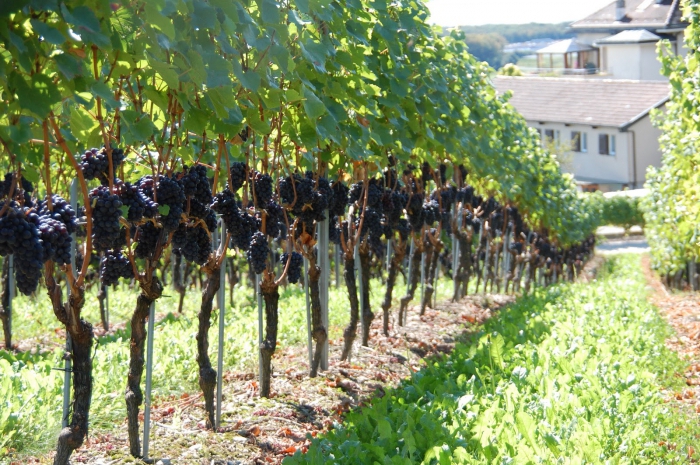
According to knowledgeable winegrowers, the most favorable time for pruning is autumn. Illiterate work, or lack of it at all, can provoke diseases and affect productivity. Autumn pruning, the most important agricultural event, and it must be carried out, adhering to all the rules.
Content
- 1 Grapes - a bush structure
- 2 Why crop
- 3 Pruning rules
- 4 When to trim
- 5 Features of spring and autumn pruning
- 6 When to prune grapes in autumn
- 7 Step-by-step instruction: how to cut grapes in autumn
- 8 How to prune young grapes in autumn
- 9 Care for grapes before and after pruning
- 10 Crop by year
- 11 Cropping for rejuvenation
- 12 Mistakes
- 13 Reviews
Grapes - a bush structure
To carry out pruning correctly, you need to understand how the plant works, what parts are intended for what, and how they differ.
What is underground
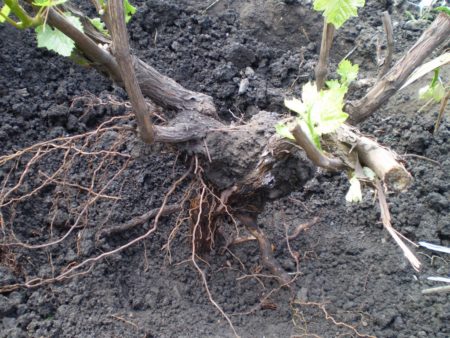
At a soil depth of 30-60 cm is the main root system - the stamb. But, depending on the terrain and soil, it can reach 4 or more meters. The base of the stem ends with a heel. In width, the roots grow to 3 meters in diameter. Therefore, you should remember this, assuming the planting of plants next to the grapes. Over time, the old roots die off, and the young ones develop.
What is above ground

The vertical stem above the ground from which the shoots are formed is called the head. Lateral shoots growing from the main stem are called sleeves or shoulders. This is a perennial (old) part of the bush. Short branches extending from them are horns.
A branch with 10 buds (long sleeve) is called the fruit arrow. After the end of the growing season, it is removed, and from young shoots formed on the knot of substitution, make a new one that will bear fruit.
A vine with a pair of kidneys left after trimming (short sleeve) is called a replacement knot. It grows under the fruit arrow. The shoots grown on it will serve in the fall to create a fruit link. The branch consists of fruit arrows and a knot of substitution.
Seals on a branch are called nodes. The internodes can be of different lengths. Education on the nodes is called the eye. It forms kidneys. There is one main and several substitutes. The young shoots that grew from the base of the leaves are stepsons.
Kidneys that were "sleeping" can give a new shoot from the stem. When rejuvenating the vine bush, they are left, and they give new life. If the grape bush is good, then they need to be pruned, as this young growth weakens growth and hinders productivity.
Antennae grow on nodes. They serve to ensure that the plant can attach and stay on a support. One antennae can withstand a load of up to 10 kg.
Why crop
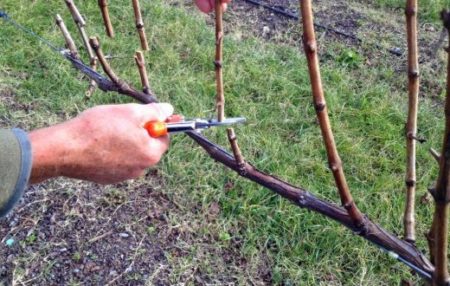
The normal growth and development of a plant depends on the nutrition of the bush. And pruning regulates the distribution of nutrients in the vine bush.
Vertical polarity is the stretching of a plant up to the light. All nutrients are spent on this growth process. The lower part of the grapes, however, suffers from their shortage.
To get a crop from the upper and lower branches, it is necessary to distribute the intake of nutrients throughout the plant. After trimming, the polarity changes, and the bush begins to develop on all branches (self-preservation instinct).
Trim Purpose:
- increase yield;
- make the berries better, the largest;
- to form new fruiting branches;
- rejuvenate and heal the plant;
- remove old unnecessary branches for better penetration of sunlight and heat transfer.
Pruning rules

It is important to know what the crop gives - a long vine, it is also a fruit arrow. And the growth of the bush is a replacement knot, it is also a short branch.
Cutting off the vine, you need to leave a “stump”, about 3 cm. In the case when you remove more, then in this place the branch may dry. Remove immature vine to the woody part.
Do sanitary pruning: destroy diseased and bad shoots. Young pagons for further fruiting leave those that are closer to the center. They need to get rid of stepsons. All fruiting vines that have already been harvested - cut.
General rules for autumn pruning:
- up, the kidney that is in the internode should look. Cropping is done there;
- sections should be smooth, without breaks and torn parts of the crust;
- sharp secateurs;
- secateurs are perpendicular to the shoot;
- thick branches are cut off with a file;
- sections are made to the inside of the plant.
How many eyes to trim
Depending on the method of forming the vineyard, the number of eyes varies.
Applicable Methods:
- A short pruning method involves the destruction of most of the vine. Up to four eyes remain on the fruit bearing arrow;
- the middle method - after removing the excess, the branch has up to ten eyes;
- long method - about ten eyes are left;
- mixed method - both methods are long and short at the same time. On three eyes, branches are removed to replace, fruit remain intact. So the loop turns out. When the fruits are harvested, everything is removed. In that place a young fruitful pagon grows.
When to trim
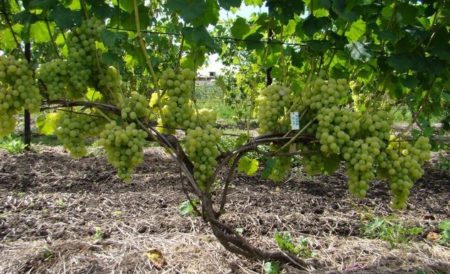
Depending on the age of the grape, its variety, climatic conditions, one or the other is done. The event can be held in spring or autumn.
The grape bush has growth stages:
- Young grapes. Age to five years. All this time he does not bear fruit, but fruitful branches of the vineyard are created. Trimming is needed for this.
- Ripe grapes. Until the age of 25, the vineyard bears fruit. Pruning is done so that new shoots grow. Old - removed to create fruitful branches of the bush.
- Old grapes. To continue fruiting and rejuvenation of the bush, compulsory pruning is performed. This is done when the plant dies away.
Features of spring and autumn pruning
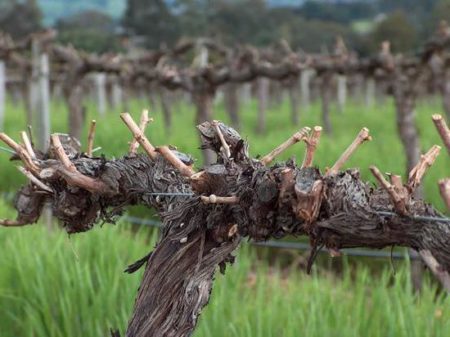
Spring pruning is performed before the swelling of the kidneys. Until then, until the sap flow began on the branches. It should be noted that the vine lets out the juice, and the kidneys may die. This type of pruning is used in the southern regions. It is suitable for grape varieties that do not need to be warmed. Also, in the spring, a complete rejuvenation of the bush is carried out.
Autumn pruning is done after dumping all the foliage. The grape bush at this time does not receive nutrients to the extent that it needs them. Bait and warming for the winter are mandatory procedures. This method is used in cold regions.
When to prune grapes in autumn
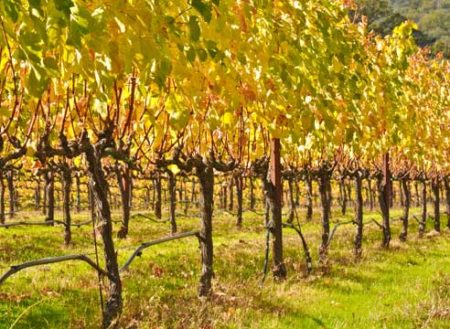
After dormancy, autumn pruning is performed. When the bush is deprived of all leaves and the metabolic processes of its life will slow down. This means that you can trim without harm.
If the circumcision procedure is carried out earlier, then the plant may get sick, not get everything you need from the leaves, or let the juice go. Only when the first frost sets in, the grape bush is ready for pruning. By that time, the vine had already taken the beneficial substances from the leaves.
Step-by-step instruction: how to cut grapes in autumn
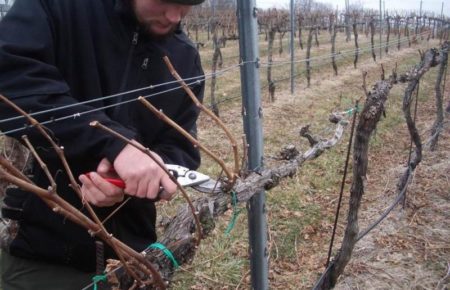
Even in hopeless cases, proper care and various manipulations will help bring the shrubbery of grapes in order and achieve good yield.
- You need to start with clearing. After all the berries are removed from the bush, you need to remove those branches on which the fruits were.
- Remove branches with less than 7 eyes.
- Shorten side shoots to 3 sheets and cut off new shoots on perennial sleeves that have reached a size of 50 cm.
- Cut branches to 10%, which reached the 1st m.
- Form future fruit links on each sleeve: substitution vine and fruit branches. There should be 3 eyes on the substitution knot. Grow, he should, below the fruit arrow. From 5 to 15 eyes should remain, depending on the length and diameter of the branch.
- Throughout the bush, at a height of about 1 meter, from the best two vines, create a fruit link.
- For next year, you need to choose and leave 2 shoots. Trim the top like a fruit arrow, lower as a substitute knot. These branches will bear fruit next year. On annual young branches only new shoots bear fruit.
- After pruning, the vine must be bent to the ground and covered. Grapes winters well under the cover of the earth. The use of "non-breathing" materials is prohibited.
How to prune young grapes in autumn
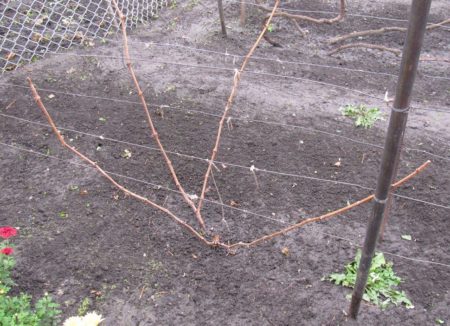
Annual and two-year-old seedlings are considered young. According to experienced gardeners, it is better to prune young vine bushes in spring. Since a bush untouched by secateurs tolerates winter better. Given that plants are still “children,” they are more likely to freeze than adult grapes. Young growth is trimmed to create a crown shape. The cropping rules are the same as in the first year.
At the end of summer, the tops of the main skeleton must be tied down. In the second half of October, remove the unripe portion. In spring, a plant that has reached two years of age is cut off, leaving 2 buds at the main branches. In the autumn, for the development of grapes, young shoots are removed, and pinch the side stepsons.
Care for grapes before and after pruning
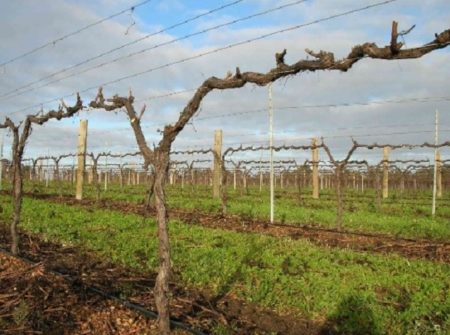
Like any surgical operation requires preparation and postoperative care, so an “operation” with a grape shrub requires attention.
First, you need to do the following:
- Examine the bush for the presence of diseased sprouts. Get rid of them.
- Peel the branches from the residual foliage and remove the green shoots.
- Also, the plant needs to be watered, fed, cuttings prepared.
- To prevent diseases. You can use copper sulfate or other means.
- When the vine is completely dry, the bush can be insulated and covered.
Crop by year
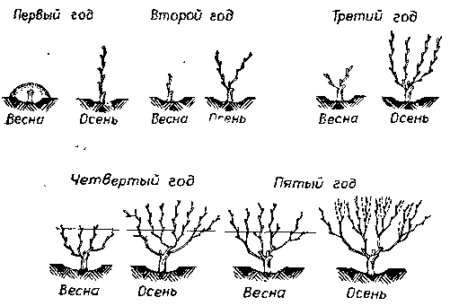
Autumn is the time for gardeners to harvest and carefully prepare the vineyard for wintering. This event involves annual pruning and other manipulations.
First year
In early April, you can remove the shelter and tie the vine so that the tops looked in different directions. The central pagon must be removed. Two lower kidneys - leave. In the summer of them 2 shoots will grow. In autumn, do not touch a pair of eyes from below. Cut the rest. Insulate for the winter.
Second year
In the autumn, cut off the long sleeve, leaving 2 branches. Also remove the stems that grow lower on the main, leave two buds. Form a knot of substitution. Form fruit arrows as follows: cut off the vertical stems, leaving 4 buds each. In the second year there should already be 4 shoots. Cover the vine.
Third year
Leave the vertical knots of substitution. In early August, cut the stems 10-20 cm., The so-called coinage. If the work is done earlier, then the vine will release a lot of extra and useless processes. This procedure is needed in order to increase the quantity and improve the quality of berries.
In the autumn, at the indicated time, remove 4 extreme vertical shoots with part of the sleeve. On each shoulder there should be one branch with two pagons. The rules are the same as in the second year. Remove the shoot closest to the center, leaving 2 buds, at the extreme - 4 buds. To be sure, if something freezes, up to 10 spare eyes on each can be left on the shoots. In the spring, excess can always be cut. A good amount is 3 buds on substitution knots and 6 on fruit shooters.
Fourth year and subsequent
All subsequent years of growth of the vine bush, do everything in the same way as in the third year. After the procedure, the grape bush has four sleeves and four fruit links. All subsequent years, trim the same.
In autumn, shorten the upper fruit arrow to 8 eyes, and the lower pagon to 2-3 eyes. Tie up the vine. Grape bush formation ends in this period.
Cropping for rejuvenation
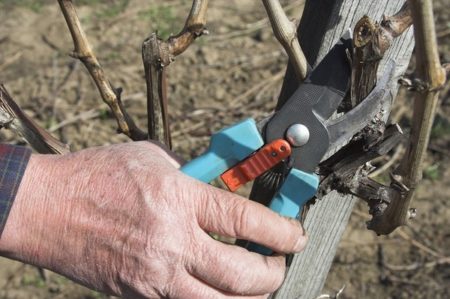
Rejuvenation of the vine is carried out by the method of updating the sleeves and the complete rejuvenation of the grape bush. In the first case, first you need to check if the vine is alive. At the base of the sleeve, you need to incise the bark and see: if the fibers are alive, then the plant can be reanimated. It is necessary to remove dry shoots and cut the sleeve for 2-3 buds from the base. Thus, "hemp recovery" is created.
If the grape stem is damaged by a disease or pests, it must be uprooted, such a bush cannot be saved. The rejuvenation procedure should be carried out in spring, so that in the summer a new shoot will grow. Leave a couple of strong vines out of it, and cut them into 3 eyes in the fall. For complete rejuvenation of the bush, you need to trim the entire ground part, and clear the ground to a depth of 30 cm around the stem. Make a few cuts on it. Cover the slice with moist soil. Harvest in the rejuvenated vineyard will be in a couple of years.
There is another way to renew the grapes. Need to make layering from the bush. It is necessary to bury a mature vine in the ground to a depth of 40 cm, stretching the branch in length. All kidneys must be removed from it. On the surface leave a vine with 2 buds. By the next summer, new pagons will appear.
Mistakes
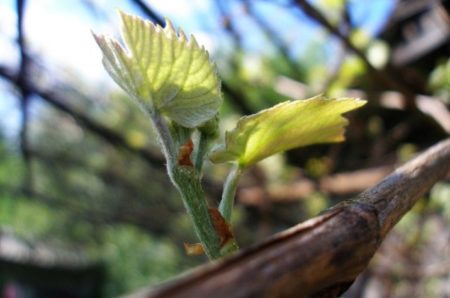
The most common mistakes lead to loss of productivity, poor development of the plant, or even death.
Minimum top cut
Long, large and beautiful branches are “sorry” to cut. Trimming occurs “slightly”. As a result, the lack of light for the vine, it becomes thin and the bush overgrows. The berry becomes shallow. Properly, you need to remove up to 70-90% of the increase.
Wrong shoots cut off
Beginner growers either cut off all the young shoots, and leave the old vine, or vice versa - the adult vine is removed, and young shoots are left. A double mistake is allowed. It is correct to cut annually shoots that have already fructified, as well as a thin vine that thickens the bush. To harvest next year, it is advisable to leave a stand with several sleeves and young branches.
Hemp
The size of the hemp left is not taken into account, it is either cut off without a trace, or left too large. On adult shoots, according to the rules, there should be no more than three cm. On new vines, so that the cut does not rot, the stump should not be left.
Stepson
Young shoots do not break off, and they grow all summer. Or vice versa, they are cut completely end-to-end to the main branch. It will be correct to leave two leaves and break off the stepsons above, removing the top.
Reviews
According to experienced winegrowers, if you follow all the tips and adhere to the rules, the result will always be positive. You can save and multiply the crop. You just need to figure out how to cut the grapes correctly in the fall, when and by how much. Which eyes to leave, which branch, specifically, to cut, what to process and how to wrap.

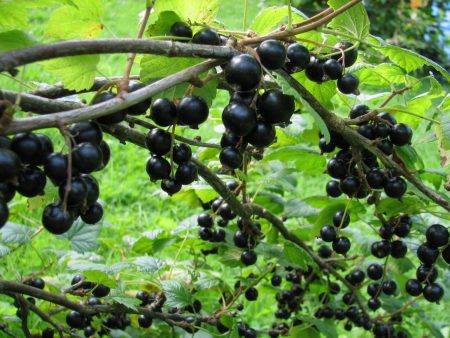




 Non-covering winter-hardy grape varieties for Moscow region
Non-covering winter-hardy grape varieties for Moscow region How to keep the vine in winter
How to keep the vine in winter When can I transfer grapes to another place in the fall
When can I transfer grapes to another place in the fall How to cover and prepare grapes for the winter in the suburbs
How to cover and prepare grapes for the winter in the suburbs
Olga
Thank you for a clear, understandable story with a video review about the technique of planting and growing grapes.
I pruned in the fall and in the spring the pruned shoots began to cry a lot; the vines disappeared; it is not indicated anywhere how to cover the places of pruning correctly and whether to cover them up please reply in advance, thanks